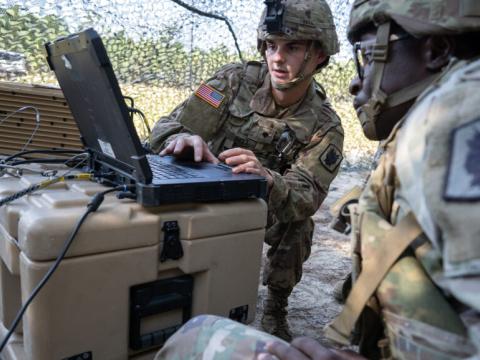Wireless Devices Unchained
Manufacturers are poised to release new equipment that will permit universal roaming for cellular telephone and mobile devices. Recent processor and software developments are leading to products that can operate across different global communications protocols.
New applications permit data, message sharing between communications protocols.
Manufacturers are poised to release new equipment that will permit universal roaming for cellular telephone and mobile devices. Recent processor and software developments are leading to products that can operate across different global communications protocols.
Roaming issues are both a hurdle and a holy grail for seamless international and national wireless use. While Western European nations offer unified and relatively interconnected service through the global system mobile (GSM) protocol, there is little or no exchange with the code division multiple access (CDMA) networks found in the United States. Interoperability for voice communications has begun to grow between the two protocols, but it still does not exist for a growing number of third-generation (3G) features such as text messaging and multimedia services.
Several technologies entering the marketplace may greatly increase the ability of wireless providers to offer seamless roaming capabilities for customers in the near future. These systems are being put forward by major wireless equipment manufacturers such as Lucent Technologies and Nokia.
Lucent Technologies has developed a cellular base station that permits cellular telephones from two different protocols to communicate with each other. Although the Flexent Modular base station carries calls on the CDMA standard only, it can ferry calls from related standards such as wideband CDMA (WCDMA) and CDMA20001x EV-DO, which have 3G capabilities.
According to Jack Kozik, director of wireless architecture for Lucent’s Mobility Solutions Group, Murray Hill, New Jersey, packet-based technology is a key driver behind the growing interoperability of wireless communications systems. He notes that both CDMA and GSM are both packet-based. These systems operate in the same manner as Internet-based packet systems by sending out small bursts of data that are reconstructed into a message by the receiving device. The only difference is the medium, he says. Besides leading to common radio architectures for equipment platforms, Kozik predicts that packet-based technologies will be a vital part of future interoperability standards for vendors.
Major service providers such as Sprint PCS and Verizon Wireless have used CDMA packet-based technology for nearly a decade. Variants of the protocol such as CDMA2000 add higher access speeds and data channels to the existing system. Although the technology has advanced in small steps, it has matured over the past decade, Kozik says. Commercial CDMA packet data systems support up to 144 kilobits of data per second. However, because this takes place over a shared network with usage spikes, actual speeds are usually 50 to 60 kilobits per second.
Newer wireless systems currently being tested will be able to achieve bit rates in excess of 1 megabit per second on a shared cell site. “You substantially get ADSL [asymmetric digital subscriber line] or higher speeds. These are things now under trial. Some of these packet data technologies that we put in the future category are being built right now,” Kozik maintains.
Packet-based systems also help preserve spectrum, which is a scarce resource in many urban areas and very expensive for carriers to use, he explains. The advantage of packet-based systems is that they occupy bandwidth only when a user is directly accessing the system.
The Flexent Modular base station is envisioned as part of a larger network that will permit universal roaming. Although some years away, this connectivity will reach from individual cellular telephones and other wireless devices to base stations and back-office servers. The goal is to take users’ home services and extend them to any network they may be visiting, Kozik explains. “Today I can sort of do that with call forwarding from my network if I travel to Europe. But basically my services don’t roam with me,” he says.
Vendors such as Lucent also are building servers that communicate in a variety of protocols to permit data exchanges between networks. Kozik notes that recent experiments by firms such as Nokia have shown the technical feasibility of sending short multimedia messages between protocols. Such messaging services may soon rival existing call-forwarding functions already operating across many protocols. “In the future, you’ll see more service interoperability roaming between networks. A lot of that goes beyond the infrastructure in the base stations. It goes to the servers in the back office of the network,” he notes.
But the ultimate goal is providing users with a seamless roaming experience, Kozik maintains. Using the example of the Internet, he offers that today’s users basically get the same service experience logging in at home, at work or on vacation. The objective is to have users’ mobile telephone services follow them wherever they go.
Some hurdles exist, however. Kozik notes that, aside from technical challenges, a major issue is to attract a large part of a given market. New wireless devices often are targeted at specific segments such as business users or teenagers. A number of roaming technologies are now in use with the commercial sector, and the challenge is to roll them out to the mass market, he says.
While companies like Lucent are developing technologies to manage the back end of a seamless roaming system, handset makers such as Nokia are concentrating on building new personal communications devices to facilitate roaming. Although voice roaming among CDMA and GSM protocols is becoming more common, next-generation devices and networks will permit users to share and access data such as text messages, images, video and Internet browsing. Some of these functions already are available on CDMA or GSM networks, but the information cannot be shared between both protocols.
In late 2002, Nokia engineers demonstrated a method to exchange multimedia messages between CDMA and GSM networks. The cellular telephone manufacturer achieved this with commercially available technology based on common international wireless protocols.
A major driver for roaming technologies has been the rapid growth of wireless multimedia and text messaging systems, explains Petteri Putkiranta, director of Nokia’s CDMA business program for mobile software, San Diego. He notes that text messaging services are deployed successfully in the United States with CDMA, GSM and time division multiple access carriers. Transferring text messages between networks requires a small conversion to be made in the message, switching between 8-bit GSM and 7-bit CDMA transmissions, he explains.
The success of messaging systems and the potential for further interoperability is being taken very seriously by the industry, Putkiranta says. “People agree that the handset implementations and how you format messages—how your device communicates its capabilities to the network—have to be agreed on and standardized. This is because the system has to know the handset version, who’s sending and who’s receiving a message so that it can convert it to the right type of format,” he shares.
Standards and protocols are important because of wireless devices’ wide variety and capabilities. Some handsets have black and white displays, others use color, and some have memory constraints limiting the types of services they can access. These limitations also affect wireless browsing because Web servers must determine the display capabilities of the device.
Although some technical challenges still exist for cross-protocol roaming, the main unresolved issue is how to integrate the various specifications among the major equipment manufacturers. Firms such as Ericsson, Motorola, Siemens and Nokia have created a multimedia messaging system conformance document to outline how to apply these various specifications. The new multimedia messaging standard used by Nokia was recently approved for CDMA. “We can quite fairly say that cooperation between competing companies has been good because it’s clearly in everybody’s interest that this thing works,” Putkiranta says.
Multimedia messaging systems are already available on both CDMA and GSM networks. Putkiranta notes that Nokia has more than 400 commercial multimedia systems and services running for GSM systems. Although no publicly acknowledged industry document for CDMA interoperability exists, he adds that Nokia does have its own commercially available CDMA to GSM conversion system for multimedia messaging. The company’s solution is commercially available, and Nokia is actively marketing the new system with U.S. CDMA carriers to boost the market and connect with GSM carriers, Putkiranta says.
He notes that nearly all of Europe’s GSM wireless operators can roam on the continent and North America, but this is not the case with CDMA. Although CDMA has a roaming capability in the United States, it is not seamless because carriers tend to concentrate their coverage in urban areas, he observes.
Putkiranta believes that multimedia messaging is a key future service that will boost use of the data networks currently under construction; however, challenges remain in organizing commercial agreements between carriers to cover inter-network roaming. These systems also must connect to other packet data networks and back to their home servers. Reaching these agreements typically takes a long time, he says. For example, networks exist under the general-packet-radio-service Edge standard. These networks are under U.S. and European operators’ packet data roaming agreements, but the agreements are not yet as comprehensive as voice roaming agreements, Putkiranta observes.
While equipment and handset manufacturers are developing systems to carry multiple transmission protocols, Qualcomm Incorporated has released a chip that permits global roaming. The San Diego-based firm’s MSM6300 mobile station modem chip set and system software integrates a GSM modem with a CDMA modem. Company officials claim the chips will enable manufacturers to design wireless devices that allow GSM carriers to deploy 3G CDMA2000 networks. These systems will permit users to roam across CDMA, GSM and general packet radio service networks. Sample shipments of the MSM6300 began in the fall of 2002, Qualcomm officials say.
Additional information on Lucent Technologies is available on the World Wide Web at http://www.lucent.com, Nokia at www.nokia.com, and Qualcomm at www.qualcomm.com.




Comments